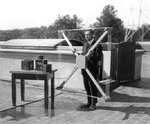drkirkby
Full Member level 6
I am looking to make a loop antenna to receive one of the 250 kW 100 kHz Loran-C transmitters, which like GPS are designed for navigation but can be used to develop a frequency standard.
I am in South-East England, but the nearest transmitter is at Lessay in northern France about 400. km away, although there's one in Anthorn northern England too.
The output of the loop will feed into a common base amplifier, which will have an input resistance of about 3 Ohms. The amplifier will be powered by 5.6 V which is on the BNC antenna connector on a Stanford Research FS700 frequency standard.
I am interested in finding out the best way to make this. A few things are obvious
1) The capture area increases with the area of the loop. I have made my loop 1.5 x 1.0 m, as that's about the biggest practical size I am willing to tolerate
2) The output voltage from the loop rises as the number of turns is increased. But assuming a constant thickness of wire, increasing the number of turns increases the resistance so increases the thermal noise voltage.
One reference I found stated that the signal to noise ratio depended on the mass of copper used. It stated a single turn using 1 lb of wine has the same S/N as 100 turns if 1 lb of wire is used.
A few things are puzzling me though
1) Is there any point worrying about the thermal noise of a loop antenna when the atmospheric noise at 100 kHz is so high?
2) Should the loop be wound with a piece of wire which has the same DC resistance as the input impedance of the amplifier? I have not measured it but I am led to believe that the input resistance of the common bsse amplifier is 3 Ohms.
I happen to have abiut 100 m of 2.5 mm^2 wire which has a DC resistance of about 0.7 Ohms, whuch us about a fifth of the input resistance of the amplifier. Would I be better to replace the 2.5 mm^2 wire with a 100 m of thinner wire (lets say one fifth the area, so aboutv0.5 mm^2) to better match the amplifier to get maximum power transfer? Doing so would give the same voltage, but sqrt (5) as much thermal noise voltage.
Buying another 400 m of 2.5 mm^2 wire is too expensive, so if I do decide to increase the loop resistance to 3 Ohms it will be by using a thinner wire.
Due to the fact that the Loran-C transmission is around wide (100 +/- 20 kHz), the loop must be untuned.
Any thoughts?
I am in South-East England, but the nearest transmitter is at Lessay in northern France about 400. km away, although there's one in Anthorn northern England too.
The output of the loop will feed into a common base amplifier, which will have an input resistance of about 3 Ohms. The amplifier will be powered by 5.6 V which is on the BNC antenna connector on a Stanford Research FS700 frequency standard.
I am interested in finding out the best way to make this. A few things are obvious
1) The capture area increases with the area of the loop. I have made my loop 1.5 x 1.0 m, as that's about the biggest practical size I am willing to tolerate
2) The output voltage from the loop rises as the number of turns is increased. But assuming a constant thickness of wire, increasing the number of turns increases the resistance so increases the thermal noise voltage.
One reference I found stated that the signal to noise ratio depended on the mass of copper used. It stated a single turn using 1 lb of wine has the same S/N as 100 turns if 1 lb of wire is used.
A few things are puzzling me though
1) Is there any point worrying about the thermal noise of a loop antenna when the atmospheric noise at 100 kHz is so high?
2) Should the loop be wound with a piece of wire which has the same DC resistance as the input impedance of the amplifier? I have not measured it but I am led to believe that the input resistance of the common bsse amplifier is 3 Ohms.
I happen to have abiut 100 m of 2.5 mm^2 wire which has a DC resistance of about 0.7 Ohms, whuch us about a fifth of the input resistance of the amplifier. Would I be better to replace the 2.5 mm^2 wire with a 100 m of thinner wire (lets say one fifth the area, so aboutv0.5 mm^2) to better match the amplifier to get maximum power transfer? Doing so would give the same voltage, but sqrt (5) as much thermal noise voltage.
Buying another 400 m of 2.5 mm^2 wire is too expensive, so if I do decide to increase the loop resistance to 3 Ohms it will be by using a thinner wire.
Due to the fact that the Loran-C transmission is around wide (100 +/- 20 kHz), the loop must be untuned.
Any thoughts?

